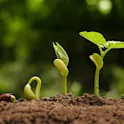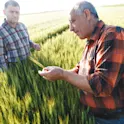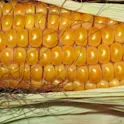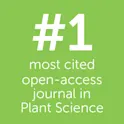
Life sciences
16 Oct 2017
Taking the brakes off plant production: not so good after all
Speeding up the slowest part of photosynthesis to increase plant yield doesn’t work in practice, finds a study in Frontiers in Plant Science

Life sciences
16 Oct 2017
Speeding up the slowest part of photosynthesis to increase plant yield doesn’t work in practice, finds a study in Frontiers in Plant Science

Frontiers news
02 Oct 2017
Frontiers in Plant Science is pleased to announce the launch of a new section, ‘Crop and Product Physiology’

Environment
26 Jul 2017
Scientists demonstrate that the indigenous knowledge of smallholder farming communities may yield genomic targets useful for wheat breeding.

Life sciences
23 May 2017
The Research Topic, published in Frontiers in Plant Science & Frontiers in Microbiology, aims to cover all aspects of biotrophic plant-microbe interactions

Sustainability
15 Dec 2016
Using crop models as a tool to assist nitrogen management decisions in corn as a win-win for the agronomy business and the environment — By Kate E. Larkin — With an innovative modeling approach, researchers set out to examine corn and soybean yields and optimal nitrogen (N) fertilizer rates. In their study, recently published in Frontiers in Plant Science, they uses a 16-year long-term dataset from central Iowa, USA, with a state-of-the-art simulator that modeled corn and soybean yields, improving predictions of optimal N fertilizer rates for corn. This has global relevance for food security and sustainable agricultural practices in light of future climate change scenarios. Corn, also known as maize, is one of the top three staple crops farmed globally with global production predicted to rise from 720.8 million tons in 2015 to 872.9 by 2030, according to the Food and Agriculture Organization. Corn also requires large nutrient supplements in the form of fertilizer due to its fast-growing, nitrogen hungry characteristics. And global demand is growing. “A huge challenge in agriculture is predicting the optimal N fertilizer rates which, if fine-tuned, can reduce N losses and increase profits”, explains Laila Puntel, a graduate student and research assistant […]

Featured news
08 Nov 2016
Two major dependencies can be alleviated by increasing legume cultivation. These are the dependency of nitrogen fertilizers and the dependency on imports.

Sustainability
12 Sep 2016
by Emily Barker, Frontiersin.org Modified crops are nothing to be scared of and could be essential in solving the global sustainability crisis, explained Dr. James Lloyd, Deputy Field Chief Editor for Plant Biotechnology in the open-access journal Frontiers in Planet Science. Much of southern Africa is currently suffering consecutive seasons of drought, and farmers in Eastern Kenya have lost more than 80% of their crops due to lack of rain. These droughts, caused by climate change, could potentially leave 36m people across Africa facing hunger. However, there is hope in drought resistant crops. Over a five-year period, a total of 2.9 million farmers in 13 African countries saw their yields increase by 20% to 30% after sowing a variety of drought-tolerant hybrids. “I think that using this type of technology has huge potential to increase crop yields and I would be optimistic that we can increase food production as we need to in the next years or so,” he added. Making modified starch more ecofriendly Dr. Lloyd and his team, who are based in South Africa, have currently been working on increasing the amount of phosphate that’s bound to starch by manipulating plant genes. Modified starch is used by the paper […]

Environment
23 Aug 2016
Researchers read into the biological history of plants to reveal how plants will survive when birds and bees fly away.

Life sciences
01 Aug 2016
by Juan Jovel, Frontiersin.org It may sound like something from a fantasy book, but scientists have found that trees seem to go to sleep at night. One hour after sunset, tree branches start dangling and continue doing so throughout the night, reaching their lowest point about 9-11 hours after sunset, new research published in the journal Frontiers in Plant Science has found. When morning comes they start to return to their normal position, which takes another three hours. The daily position of the branches and leaves allows trees to maximize their capture of sunlight, which fuels their biomass-producing processes, while the drooping position probably reduces the loss of heat during the night. Circadian rhythms refer to biological processes that cycle roughly every 24 hours and explain, for instance, patterns of sleeping and feeding in animals. The scientists from Finland, Austria and Hungary, setup to investigate whether silver birch trees experience movement patterns in a circadian fashion. They used a sophisticated technique called Terrestrial Laser Scanning (TLS), which allows monitoring the movement of objects, including trees or parts thereof, during day or nighttime. Dr. Eetu Puttonen, from the National Land Survey of Finland, and his international collaborators, used TLS to monitor the […]

Frontiers news
24 Nov 2015
Frontiers in Plant Science has an Impact Factor of 4.495 and is the largest and the most cited open-access journal in Plant Science.

Frontiers news
02 Nov 2015
In just 5 years, Frontiers in Plant Science has become the 3rd largest and the 7th most-cited Plant Science journal in the world. The Impact Factor (IF), defined as the total number of citations in a given year divided by the number of citable articles over the previous two-year period, is the most commonly accepted metric of journal quality (but not of an individual paper or researcher). It was formally established by the Institute for Scientific Information (ISI) in 1975. As the IF can be heavily skewed by a few highly-cited papers, total citations generated over the same two-year period provide a more accurate indication of the overall influence or impact of the articles published by a journal in a field. Frontiers is a pioneer in the use of article-level and author-level metrics and encourages every author to use these to track the development of his or her readership on a more granular level. Analysis within the category of Plant Sciences There are 204 journals are listed in the category of “Plant Sciences” in the 2014 Journal Citation Reports (JCR) published by Thomson Reuters in 2015. Frontiers in Plant Science is one of 33 Gold open-access journals. Below are the results of our comparative analysis of these journals on the article volume published, impact […]
Get the latest research updates, subscribe to our newsletter